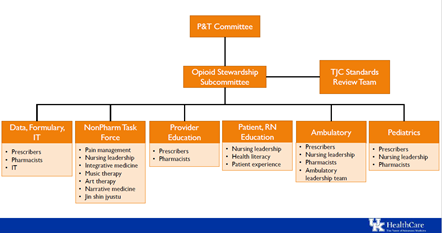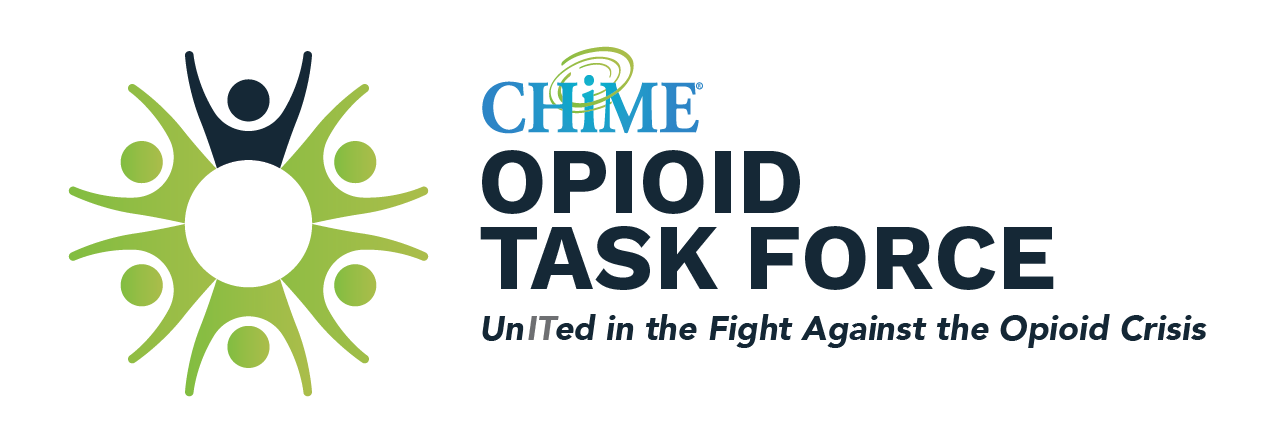Opioid stewardship committees are by no means exclusive to large academic medical centers and integrated health systems. Many smaller organizations – such as Healdsburg District Hospital, a critical access hospital in Healdsburg, Calif. – have also set up the internal structure and governance needed to support the specific scope of their respective opioid stewardship programs.
The Opioid Crisis and Pain Management Task Force at Healdsburg District Hospital (HDH) was established in July 2018 to “promote and standardize safe opioid use in pain management in the acute care setting and help combat the opioid crisis within surrounding communities.” The group – which meets every month – is chaired by the hospital’s pharmacy director, with the CNO serving as the executive sponsor. The CIO is a formal member of the task force, and there is participation from emergency physician group, district education coordinator and perioperative clinical leaders as well. The Opioid Crisis and Pain Management Task Force is responsible for a quarterly report that goes to the HDH Quality Committee and Pharmacy & Therapeutics/Medication Safety Committee, as well as a bi-annual report that goes to the hospital’s Medical Executive Committee.
Having the CIO actively involved on the Task Force right from the start was critical to HDH being able to quickly implement a number of key IT-related changes in support of their goal to reduce opioid prescriptions and standardize pain management. For example, in just the first few months alone, HDH has been able to successfully:
- Build – and modify – pain management standardized order sets in the EHR
- Identify current opioid prescribing patterns within the organization and establish a baseline to measure outcomes of the task force’s initiatives
- Implement a “pass through” in the EHR so physicians can directly access the California PDMP database at the point of care
- Implement and build a standardized Suboxone treatment protocol (in coordination with ED physician group) in EDIS (the EHR in the Emergency Department) to initiate treatment in opioid-withdrawal patients
When asked his advice to CIOs at similar-sized hospitals establishing an opioid stewardship committee, HDH CIO Bill Cioffi says, “Build a coalition – both internally and in the community – and rely on appropriate resources. IT alone can only drive the effort so far. There must be strong leadership and engagement among physicians, nursing and pharmacy, since that is ultimately where the changes and interventions take place.”
One of the biggest challenges for small hospitals – especially compared to academic medical centers and integrated health systems – is the lack of resources. However, as Cioffi points out, smaller organizations also have some advantages that CIOs should keep in mind when establishing an opioid stewardship committee. “There is usually much less bureaucracy at smaller organizations,” says Cioffi. “Here at Healdsburg District Hospital, our leaders are very accustomed to wearing many different hats and taking on new kinds of responsibilities. Active, candid communication is just part of the culture. In many ways, we can implement meaningful change much more quickly than a large organization.”
- Kaiser Permanente Southern California took a “comprehensive” approach to combat the opioid epidemic, creating “prescribing and dispensing policies, monitoring and follow‐up processes, and clinical coordination through electronic health record integration.” According to a 2017 study in the Journal of Evaluation in Clinical Practice, “Kaiser Permanente Southern California’s intervention was developed and overseen by a multi‐disciplinary team composed of physician administrative leaders, primary care, pain management and addiction medicine physicians, pharmacists, information technology leaders, and education specialists… This structure provides the critical framework needed to develop, communicate, implement, and sustain the initiative.” Results from implementing the interventions included “a 30% reduction in prescribing opioids at high doses” and “a 98% reduction in the number of prescriptions with quantities greater than 200 pills.”
- At University of Kentucky HealthCare, the opioid stewardship committee is modeled after the antimicrobial stewardship committees in many hospitals. According to Phillip Chang, MD (CMO at UK Kentucky HealthCare), the committee is responsible for “monitoring the prescribing patterns and educating physicians, nurses and pharmacists about the rules around prescribing.”

